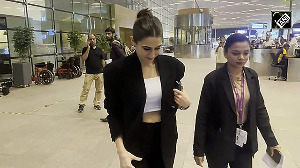Uber said it is conducting a full audit of its verification, rider feedback and support processes apart from assessing its driver screening processes, Ola is getting GPS installed in all its partner taxis.
 After governments across several states began a crackdown on internet-based taxi providers this week, 1-1.5 million people are likely to be affected.
After governments across several states began a crackdown on internet-based taxi providers this week, 1-1.5 million people are likely to be affected.
But there are divergent tales emerging after the Uber ban.
One is of chaos at places like airports — where taxis are the most sought — because of overcharging by drivers, taking advantage of the shortage of taxis.
Another is of licensed taxi operators going the extra mile to fix the now-dented trust of consumers. Even without being asked, drivers of Meru are showing their licence to passengers soon after boarding, to assure them of their credentials.
Though implementation of the ban has been patchy, about 10,000 cabs are estimated to be off roads across the country, essentially in the metro cities of Mumbai, Delhi and Hyderabad.
Even as users acknowledge the many lapses by taxi aggregator Uber in the Delhi rape case, most say a blanket ban will make commuting and leisure trips inconvenient.
On Wednesday, two days after the ban, the drop-off area at New Delhi airport was in turmoil. Many passengers for early-morning flights were running behind schedule. In the wee hours of the morning, most had relied on radio cabs to travel to the airport.
The ban had led to a shortage of taxis plying on roads. Though Uber only suspended its operations that afternoon, while others continued to ply, users were already confused about their status.
This week, the central government asked states to ensure stoppage of unlicensed web-based taxi services. While the decision was sparked by the need to regularise the taxi sector and make sure these services were safe to use, the ban might have quite the opposite impact.
A law graduate assisting a senior lawyer complained she left work late, as lawyers put in long hours. “What are the options a woman dependent on public transport has at 1 am?” she asked, adding Uber, Ola and other web-based services were at least relatively safe and affordable.
Sumeet Kaur, a Bengaluru-based entrepreneur who is a regular user of Uber, says the service was “life changing” for her. “Earlier, I used to rely on auto-rickshaws and have faced terrible behaviour from drivers. With Uber drivers, on the other hand, I never faced any issue.” She found Uber drivers always very polite and courteous. “You cannot take away a service from consumers without giving an alternative,” she added.
In India, mobile apps of the top eight taxi services have been downloaded about 20 million times. This excludes Uber’s five million downloads, which comprises its users all over the world, according to data available on Google Play Store.
Downloads through Apple’s iPhones and on the Windows platform will only shore up the numbers. Even if one considers most of the downloads as inactive, at least 1 to1.5 million people will be actively using the apps to book cabs regularly.
The number of people who use both mobile applications and the call centres for cab booking would be much higher.
Radio taxi service providers like Meru Cabs who operate both ways — traditional call centre booking route and direct mobile app bookings— get about 40-50 per cent of their bookings through mobile applications.
But these taxi operators will continue to operate through the call centre route, as they are recognised by the government as legal entities.
Kaur, who chose to take an Uber ride on Wednesday night because her husband was not accompanying her, said no matter how much she prefers travelling by it, she had become more cautious after the Delhi rape and would perhaps feel unsafe using any radio taxi service at night if she was travelling alone.
The user base of web-based taxi services has been growing at an annual rate of 25 to 30 per cent, according to Rohan Dighe of ViralMint, a marketing and consumer acquisition platform.
For any e-commerce portal, just about 10 per cent of registered users are active but the number is relatively higher in the case of taxi service providers because of the “nature of the industry”, Dighe added.
Taxi services are at least taking this opportunity to relook at their processes and try to put more safeguards in place.
Uber said on Thursday that it was conducting a full audit of its verification, rider feedback and support processes apart from assessing its driver screening processes, Ola is getting GPS installed in all its partner taxis.
Licensed operators such as Meru and Mega are going the extra mile to assure safety. “If a woman is travelling alone at odd hours, she will be contacted by the company call centre to check if she is fine,” said Kunal Lalani, chief executive officer of Mega Cabs.
A TaxiForSure spokesperson said in the wake of the recent developments, it was working with operators closely to meet the regulatory requirements. Perhaps, taxi operators are going an extra few miles to woo back their customers because it is big business now.
Photograph: Courtesy, Uber












 © 2025
© 2025